10th October 2006 - Colours of autumn
Apologies for the delay! We tried to second-guess things this summer - we thought the summer would be a quiet time for the shop and took on an IT contract. But, it didn't happen that way did it? No, the closer the deadline got, the more orders we got. Back to normal now.
Anyway, it’s that time of year again. The natural world is doing amazing things all around us and if we stop to look for a moment, there are delights and wonders to be seen everywhere.
"It might make you grimace, but it’s hard to look away"
The lowering sunlight shows us new colours, gilding leaves and flowers as it shines through or over them. Commoners like bracken become things of beauty when you see that golden light shine through the fading fronds, and you get to wince at the combination of bright orange comma butterflies as they graze over the flowers of rich pink Sedums. It might make you grimace, but it’s hard to look away.
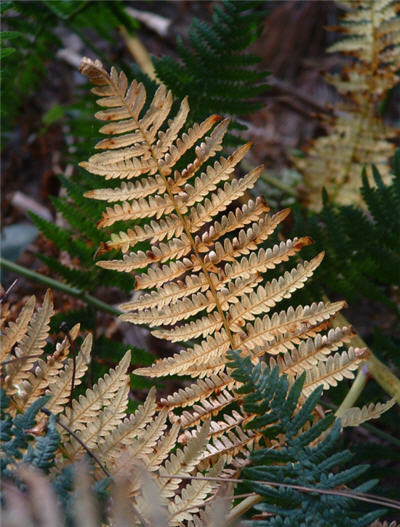
Sunlight through fading bracken
In the heavy dew of early morning the garden is festooned with glistening cobwebs, each thread strung with living jewels. Some of my earliest memories are of going out into the early morning of an autumn garden to admire dewy cobwebs and I still enjoy it now. They suddenly become visible nearly everywhere you look, and you begin to get a tiny inkling of just how many spiders there might be in the world.
In terms of flowers and seed heads, this year has been interesting because of the dramatic difference between the weather of July and August. July was so hot and dry that the lawn turned yellow and plants wilted, while during August it rained nearly every day. Plants that had gone to seed suddenly woke up and started flowering again and we could admire the faded brown heads of Achillea ‘Walter Funke’ next to the fresh new flowers it had put out.
These new flowers seemed brighter than ever in contrast with the brown of the older growth. Looking closely at each individual petal, you can see so many soft shades of orange and yellow blending into each other.
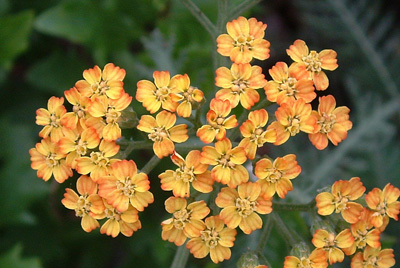
Colours of new Achillea flowers
Looking at flowers close-up is fascinating, all manner of colours and patterns are revealed that you might not suspect from a distance. A pale yellow Osteospermum acquires a real wow factor when you gaze into its centre, and becomes something you might see at a modern art exhibition. Describing the colours makes it sound a bit off-putting – yellow petals, which fade to dark purple at the base, encircle a ring of clustered yellow and black spheres, with another cluster of purple spheres in the middle of them all. How did it get like that? It seems too perfect to be real.
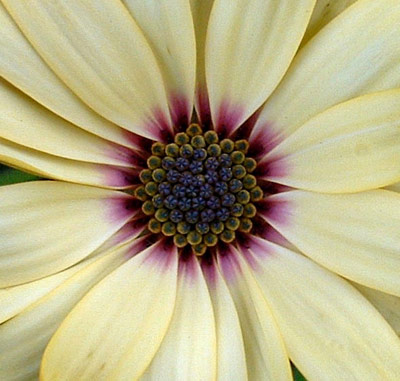
Osteospermum
Another one worth staring at up close (which also flowered again in late September) is Sisyrinchium striatum. From a distance you see a fan of lily-like, grey-green leaves and tall stems with small yellow flowers clustered along them. They look okay but nothing out of the ordinary, until you get up close and another new world appears. They’re not just pale yellow at all – the closed flowers are actually purple and as the furled trumpet shapes gradually open, they seem to be unwrapping themselves from something that looks like remarkably like cellophane and only then do they start to turn yellow.
You see then that the base of the flower is a rich buttery yellow which fades to a paler shade as it moves up the flower. Along each petal run some eight or nine fine vertical purple lines, with a central one forming part of a delicate point at the petal’s tip. Deep inside the flower its base is speckled with the same shade of purple which contrasts warmly with a bright yellow stamen.
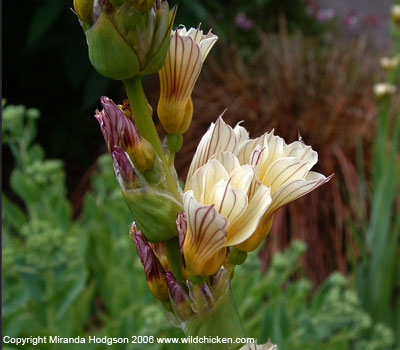
Sisyrinchium striatum
Straightening up to look around from a distance, I was struck by a combination that I hadn’t planned – a rich magenta Aster (novae-angliae? not sure, it was given as a cutting) growing in front of an orange berried Pyracantha. Did I put that there? Must have done it without thinking about the berries. Should I move it? I look again and decide that, actually, I like it where it is and will keep it there and let the clump of Asters get bigger. The colours are wonderful, so rich and vibrant. They lift my spirits and make me smile in a way that more subtle combinations do not. The golden late afternoon sun makes the berries gleam, brightens the rich magenta and picks out the orange centres of the flowers. It must stay where it is. Even the late Christopher Lloyd might approve.
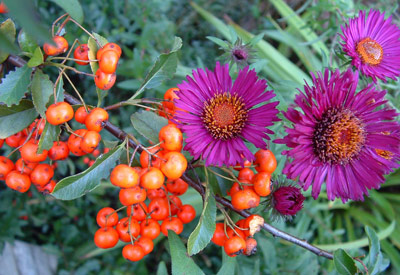
Aster flowers and Pyracantha berries
If I must be subtle, then it’s worth mentioning the new bed as it looked in mid-August. Sedum 'Herbstfreude' sat in fat clumps at the front, the unopened clustered flowers still a cream colour. Behind them were purple-blue globes of Echinops ritro and newly opened heads of lilac Verbena bonariensis. Amongst them shone the yellow flowers of self-seeded common evening primrose, Oenothera biennis, backed by tall buff-coloured plumes of ornamental grasses. Above them all, the feathery foliage of pink Cosmos bipinnatus ‘Sensation’ - grown from a packet of free seeds that came with a magazine. The flowers then were still in tight buttons but are now in full bloom.
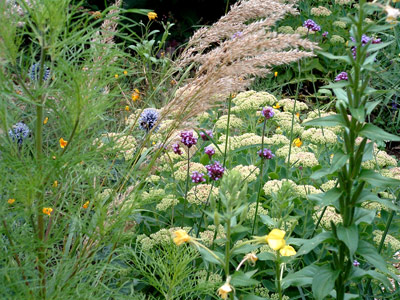
New bed in August
I was going to mention the pleasure of looking at Euonymus fortunei 'Emerald 'n' Gold' growing in front of a glaucus Juniper, but there’s another combination that I thought looked better. Very simple, and worth a go with ornamental grasses if you can find the right one, were some alliums that had gone to seed amongst the meadow grass of the abandoned allotment next to ours. I came across it by surprise - thick yellow stems of old onion flowers rose from the dense grass, which was still a rich green. There was a breeze that day and all the stems were leaning in the same direction which added to uncomplicated beauty of the grouping. It was the simplest combination of all and one of the loveliest for looking so natural.
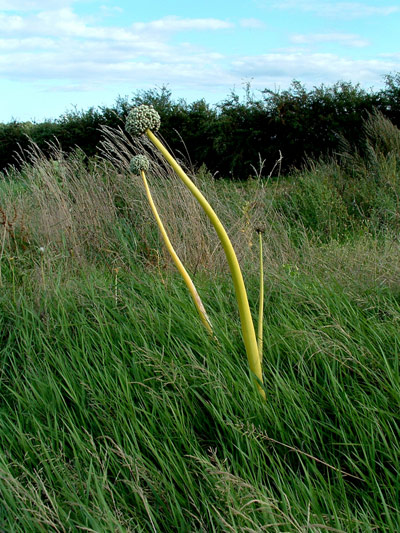
Allium flowers in meadow grass
© Copyright Miranda Hodgson 2006